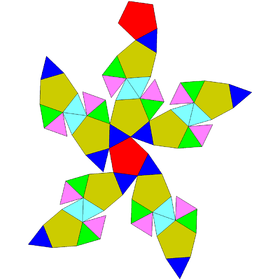Gyroelongated pentagonal birotunda
| Gyroelongated pentagonal birotunda | |
|---|---|
 | |
| Type |
Johnson J47 - J48 - J49 |
| Faces |
4x10 triangles 2+10 pentagons |
| Edges | 90 |
| Vertices | 40 |
| Vertex configuration |
2x10(3.5.3.5) 2.10(34.5) |
| Symmetry group | D5 |
| Dual polyhedron | - |
| Properties | convex, chiral |
| Net | |
 | |
In geometry, the gyroelongated pentagonal birotunda is one of the Johnson solids (J48). As the name suggests, it can be constructed by gyroelongating a pentagonal birotunda (either J34 or the icosidodecahedron) by inserting a decagonal antiprism between its two halves.
A Johnson solid is one of 92 strictly convex polyhedra that have regular faces but are not uniform (that is, they are not Platonic solids, Archimedean solids, prisms or antiprisms). They were named by Norman Johnson, who first listed these polyhedra in 1966.[1]
The gyroelongated pentagonal birotunda is one of five Johnson solids which are chiral, meaning that they have a "left-handed" and a "right-handed" form. In the illustration to the right, each pentagonal face on the bottom half of the figure is connected by a path of two triangular faces to a pentagonal face above it and to the left. In the figure of opposite chirality (the mirror image of the illustrated figure), each bottom pentagon would be connected to a pentagonal face above it and to the right. The two chiral forms of J48 are not considered different Johnson solids.
See also
External links
- ↑ Johnson, Norman W. (1966), "Convex polyhedra with regular faces", Canadian Journal of Mathematics 18: 169–200, doi:10.4153/cjm-1966-021-8, MR 0185507, Zbl 0132.14603.